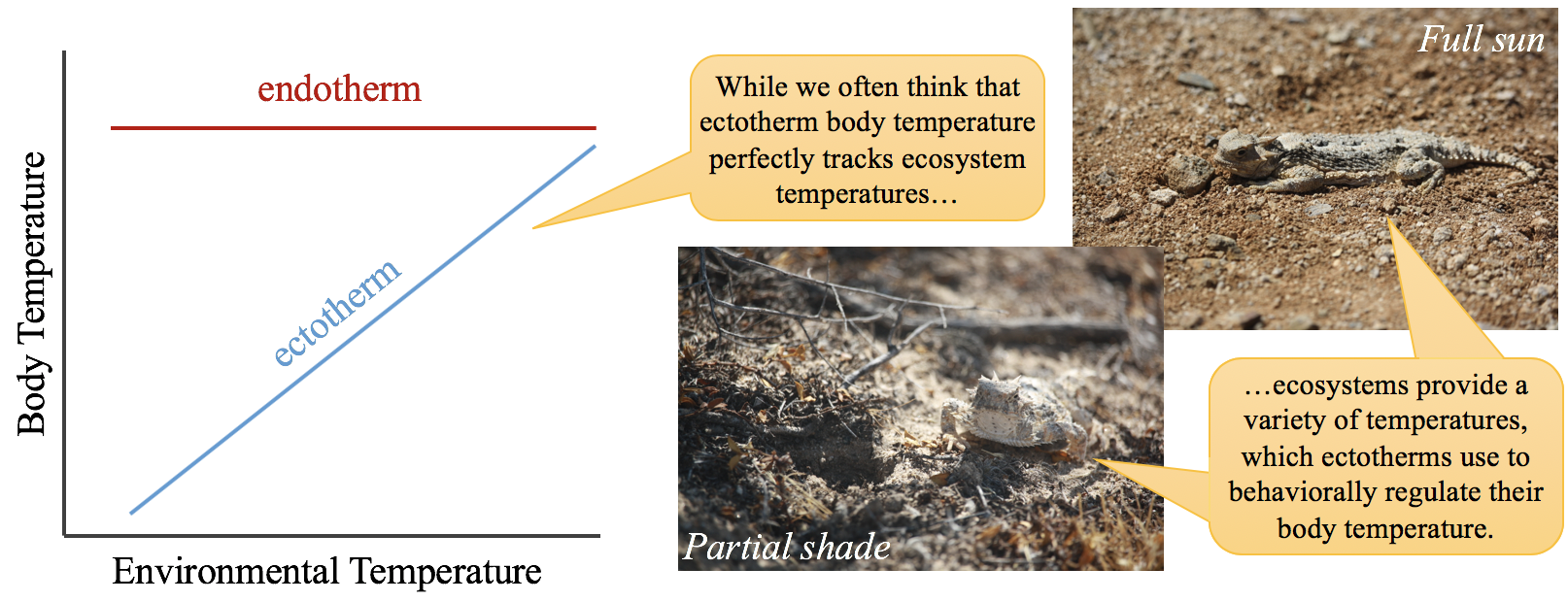5.3: Stress - Thermoregulation
- Page ID
- 62281
Thermoregulation (managing body temperature) is a critical consideration for all organisms due to the impact that changing temperatures have on biochemical structures and processes. For example, the rate at which many biochemical reactions (such as metabolism and photosynthesis) occur is influenced by temperature. In addition, temperature affects the shape, and therefore the functionality, of many enzymes and proteins. In fact, high temperatures can cause a protein or enzyme to denature, a process where the protein’s shape is so altered that it cannot function correctly. Consequently, the metabolic processes and proteins on which an organism relies will directly influence its thermal tolerance range and so, organisms have adaptational and acclimational strategies to deal with thermal stress.
Both plants and animals exhibit acclimation to thermal stressors, whereby exposure to sub-optimal temperatures is less detrimental if the individual has prior experience under these conditions. For example, photosynthetic rate in plants is affected by air temperature and plants grown in cool conditions will exhibit maximum photosynthetic rates at lower temperatures than plants grown under warmer conditions. The same has been shown for swimming speed in fish, where fish raised in cooler water are able to maintain faster swimming speeds in cold water than fish raised in warm water. These examples show a change in the phenotype of the organisms (photosynthetic rate or swimming speed) in response to the environmental stressor of low temperature.
Animals exhibit two primary strategies in thermoregulation: ectothermy and endothermy. Endothermic animals rely on metabolic processes to maintain a relatively constant internal body temperature. Mammals (including humans) and birds are examples of endotherms. Ectothermic animals rely on the surrounding environment to regulate their internal temperature. Insects, fish, amphibians, and non-avian reptiles (such as snakes and lizards) are ectotherms. Ectothermy and endothermy should not be viewed as clear and distinct categories. Some animals, such as sharks, are primarily ectothermic, but do generate some metabolic heat when their body temperature drops below a certain threshold. Similarly, some endothermic animals do not maintain body heat while hibernating. Such animals may be termed heterotherms (switching between ectothermy and endothermy) or mesotherms (relying somewhat equally on both external and internal sources of heat). Consequently, thermoregulatory strategies should be considered as a continuum with ectothermy and endothermy as extremes. Organisms may occur anywhere along the continuum and may even move across the continuum depending on environmental conditions.
A Common Misconception
Since ectotherms rely on the surrounding environment to regulate their body temperature, it is a common assumption that an ectotherm’s body temperature will follow the air temperature of the surrounding habitat. This misconception is exacerbated by figures such as the one below, which are commonly found online, and indicate that the body temperature of ectotherms directly tracks environmental temperature. This is incorrect for two reasons. First, the surrounding habitat does not exhibit a single temperature. Instead, temperature varies between sunny and shady locations, and between above- and below-ground locations, etc. Second, ectotherms do regulate their body temperature behaviorally by moving between warmer and cooler parts of the habitat, meaning that their body temperature does not necessarily track the average air temperature of the habitat.

Image and photos by L Gerhart-Barley
Both animals and plants have a variety of adaptations for retaining heat in cool environments. For example, many reptiles can alter the pigmentation of their skin and will darken their body color when basking in the sun in order to increase the heating of their body. To retain heat, many animals in cold ecosystems such as polar regions are large in size, which reduces the surface-area-to-volume ratio, reducing the amount of body heat lost to the atmosphere. Similarly, animals may also have thick layers of fat (such as blubber in whales and dolphins) or fur (such as polar bears) to reduce body heat loss to the surrounding air or water. Plants have similar growth adaptations for reducing heat loss, including short growth forms to reduce heat loss from wind, and dark, horizontal leaves to increase heat uptake from the sun.
Many adaptations for increasing heat loss in warm environments take advantage of evaporative cooling. Water has a very high specific heat, meaning that it requires a high amount of energy to increase in temperature and a high amount of energy to change phases from liquid to gas. Consequently, as water evaporates from a surface it cools the temperature of that surface. Humans (and some other mammals) take advantage of evaporative cooling through sweat. Dogs cool themselves by panting. Even plants use evaporative cooling by opening pores in the leaves (called stomata) from which water evaporates and cools the plant.
Many thermoregulatory strategies result in trade-offs. For instance, reliance on evaporative cooling produces a very serious trade-off between thermoregulation and hydration where temperature stress is managed at the expense of water stress. In addition, endothermy is energetically very expensive and endotherms invest a large amount of their overall energy budget in body temperature regulation. Ectotherms avoid this energetic cost, but often spend much of their time outside their optimum temperature range, and are more at risk of entering their zones of intolerance.


